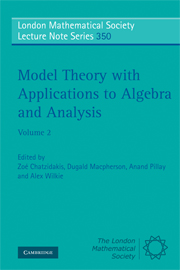Book contents
- Frontmatter
- Contents
- Preface
- Contributors
- Conjugacy in groups of finite Morley rank
- Permutation groups of finite Morley rank
- A survey of asymptotic classes and measurable structures
- Counting and dimensions
- A survey on groups definable in o-minimal structures
- Decision problems in Algebra and analogues of Hilbert's tenth problem
- Hilbert's Tenth Problem for function fields of characteristic zero
- First-order characterization of function field invariants over large fields
- Nonnegative solvability of linear equations in ordered Abelian groups
- Model theory for metric structures
First-order characterization of function field invariants over large fields
Published online by Cambridge University Press: 04 August 2010
- Frontmatter
- Contents
- Preface
- Contributors
- Conjugacy in groups of finite Morley rank
- Permutation groups of finite Morley rank
- A survey of asymptotic classes and measurable structures
- Counting and dimensions
- A survey on groups definable in o-minimal structures
- Decision problems in Algebra and analogues of Hilbert's tenth problem
- Hilbert's Tenth Problem for function fields of characteristic zero
- First-order characterization of function field invariants over large fields
- Nonnegative solvability of linear equations in ordered Abelian groups
- Model theory for metric structures
Summary
Introduction
Definition 1.1 A field k is large if every smooth curve with a k-point has infinitely many k-points [Pop96, p. 2].
This condition is equivalent to the condition that k be existentially closed in the Laurent series field k((t)) [Pop96, Proposition 1.1]. It is in some sense opposite to the “Mordellic” properties satisfied by number fields, over which curves of genus greater than 1 have finitely many rational points [Fal83].
If p is any prime number, then any p-field (field for which all finite extensions are of p-power degree) is large [CT00, p. 360]. In particular, separably closed fields and real closed fields are large. Other examples of large fields include henselian fields and PAC fields. (PAC stands for pseudo-algebraically closed: a PAC field is one over which every geometrically integral variety has a rational point. See [FJ05, Chapter 11] for further properties of these fields.) For further examples of large fields, see [Pop96]. An algebraic extension of an large field is large [Pop96, Proposition 1.2].
Definition 1.2 Let k be a field. A function field over k is a finitely generated extension K of k with trdeg(K|k) > 0.
Definition 1.3 The constant field of a field K finitely generated over k is the relative algebraic closure of k in K.
Theorem 1.4There exists a formula φ(t) that when interpreted in a field K finitely generated over an large field k defines the constant field.
- Type
- Chapter
- Information
- Model Theory with Applications to Algebra and Analysis , pp. 255 - 272Publisher: Cambridge University PressPrint publication year: 2008
- 2
- Cited by

